I am 37 years old this year. I started to trade cryptocurrencies at the age of 28 and have been doing it for more than ten years. From the blow-up to now, I have achieved financial freedom and supported my family by trading cryptocurrencies. From January 23, 2021 to May 2025, I have made less than 300,000 yuan in 4 years, and my winning rate has reached 518134.86%, which has made more than 30 million yuan. Now I have to stay in a high-end hotel of about 2,000 yuan when I go out. My suitcase and hat may have the symbol of the cryptocurrency circle. Compared with the older generation who do industry or e-commerce,
People born in the 1980s are much more comfortable. I have almost no experience in business where I have to argue with others. I have fewer worries, so I have the patience to summarize my feelings!
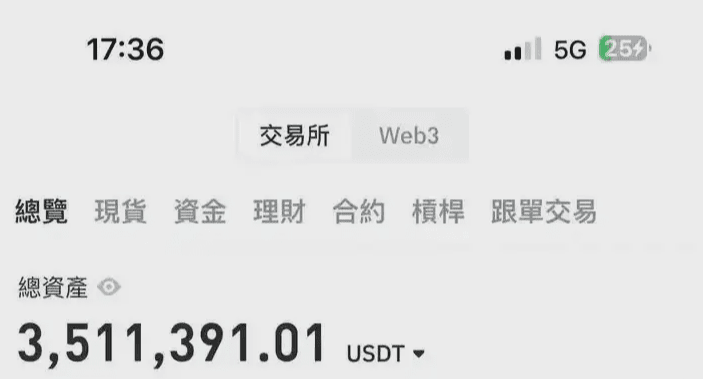
A must-read for cryptocurrency investment: 10 classic rules to help you navigate the bull-bear cycle
In the turbulent waves of the cryptocurrency market, does traditional investment wisdom still work? Although the blockchain world is full of disruptions, the investment philosophy that has stood the test of time has always been a beacon that illuminates the fog. The following 24 classic quotes are reinterpreted in combination with the characteristics of the cryptocurrency circle to help you establish a more rational investment cognition.
1. Understand the nature of the market: volatility is the eternal theme
1. The power of trends is far beyond imagination
Investment guru Baruch's "New highs breed new highs, new lows breed new lows" reveals the iron law of the cryptocurrency world: once a rising or falling trend is formed, it is difficult to reverse. Don't try to predict the top and bottom with traditional financial logic - when BTC fell from $60,000 to $20,000, the "floor price" in the eyes of bargain hunters may just be a "step under the ceiling."
2. Acknowledge the unpredictability of the market
"People who always say they can buy at the bottom and sell at the top are definitely lying." This sentence is particularly harsh but true in the cryptocurrency circle. From the flash crash of LUNA to the violent pull of PEPE, the crypto market has continuously proved with extreme market conditions that the only constant is change itself.
2. The first rule of survival: risk control is more important than profit
3. Mistakes are the norm, stop loss is a necessity
"Don't expect to be right every time. The sooner you stop loss after making a mistake, the better." In the contract market, 10 correct profits may be wiped out by 1 single order. Establishing a 5% stop loss iron rule can determine the survival cycle better than studying 100 technical indicators.
4. Always keep the capital for a comeback
Soros's "not betting everything on one throw" can be called a life-saving talisman in the cryptocurrency circle. Even if you are sure that the bull market is coming, you need to reserve 30% of the principal to deal with black swans. The collapse of FTX in 2022 made many full-position investors return to poverty overnight, while those who kept the fire waited for the rebound window in 2023.
3. Trading strategy essentials: Finding certainty in uncertainty
5. Focus on your circle of competence and go deep rather than broad
"You don't have to know everything, but you must specialize in one aspect" - instead of chasing thousands of altcoins, it is better to delve into the halving cycle of Bitcoin or the ecological development of Ethereum. Long-term holders of Binance platform currency BNB often have more stable returns than those who frequently change positions.
6. The opportunity code in the relationship between quantity and price
Gann's "volume before price" theory is also applicable in the cryptocurrency world: when the 24-hour trading volume of a currency suddenly increases by 3 times, it is often accompanied by a short-term change window; and a breakthrough after continuous sideways trading with shrinking volume, whether upward or downward, may bring more than 50% fluctuation space.
4. Guide to the Game of Human Nature: Reverse Thinking is the Key to Excess Returns
7. Stay sane amid the madness of the crowd
Rogers' "others are greedy and I am fearful" needs to be upgraded to "others are greedy and I short" in the currency circle - at the peak of the bull market in 2021, when retail investors' enthusiasm for chasing Meme coins reached its peak, smart money has locked in profits through futures short orders.
8. Beware of the fatal temptation of information cocoons
"When the media's views are one-sided, stand on the opposite side" - In 2023, when a well-known KOL collectively sang a bullish message about a DeFi project, the reverse short sellers seized the 10-fold liquidation market. In the rumor mill of the currency circle, the truth is often hidden in the opposite direction of public sentiment.
5. The principle of long-termism: the underlying logic of crossing cycles
9. Time value of core assets
Fisher's "holding on to growth stocks" corresponds to "hoarding core coins" in the cryptocurrency world. Bitcoin has risen from $0.0008 in 2009 to $26,000 in 2023, proving that "time is a friend of high-quality assets." Even in the 2022 bear market, Bitcoin's decline is far less than 95% of altcoins.
10. Research is the first prerequisite for investment
Peter Lynch's "Investing without research is like playing cards blindfolded" is particularly important in the cryptocurrency world where more than 80% of the coins are zero-valued. The more than 1,000 tokens that disappeared in 2023 prove that speculation without fundamental support will eventually burst like a bubble.
The ultimate reminder for cryptocurrency investors
The charm of cryptocurrency lies in subverting tradition, but its essence is still a battlefield of human nature. When you are overwhelmed by the myth of 100-fold coins, please reread Buffett's "fear and greed" law; when you are anxious about short-term fluctuations, remember the warning of Kawa Ginzo: "Rumors are the sickle of the banker, and patience is the hoe of the investor."
In this 24/7 market, true experts never pursue short-term profits, but use a systematic risk control system and independent judgment to build their own Noah's Ark in the stormy waves. Remember: there is no shortage of opportunities in the cryptocurrency world, but there is a shortage of people who can survive until the opportunity comes.
3,000 yuan in the currency circle is about 400u! The best solution is recommended: use 100u for each contract, gamble on hot coins, and make a profit and loss stop of 100 against 200, 200 against 400, and 400 against 800. Remember to do it at most three times! Because the currency circle requires a little luck, it is easy to make 9 times and burst once every time you gamble like this! If you pass the three levels with 100, then the principal will reach 1100u! At this time, you need to settle down. "Three-stage rocket" strategy:
Base position: Use 50% of funds to buy Bitcoin and Ethereum to seize the mainstream rising dividends.
Boshanzhai: 30% of the funds are used to purchase tokens of 5 DeFi projects with practical application scenarios.
Play contracts: use 20% of the funds to open a 5x leverage and go long when Bitcoin pulls back.
The most thrilling transaction was the contract operation. When Bitcoin dropped from 60,000 to 55,000, the market was wailing, and the RSI indicator was oversold. I decisively opened a long order and set a 10% stop loss. Three days later, Bitcoin rebounded to 65,000, and I made 400,000 from this order.
The most stable way to play the contract. Tips on making money with perpetual contracts
Practice: Fund management from 10,000 to 1 million
Iron rule of position allocation: Total funds ≤ 10,000: single coin position does not exceed 30%; 10,000-100,000: spread to 3-5 tracks (AI+Depin+chain games+RWA+public chains); > 100,000: 20% stablecoin hedging must be configured
Contract rolling formula ① First position trial: 5% position to test the direction (stop loss 3%) ② Confirmation increase: increase to 10% after 10% profit ③ Trend position: increase to 15% after breaking through the key position ④ Stop profit strategy: ladder stop profit (30%/50%/70%)
Pitfall avoidance guide • Never do: the first day of a new coin/midnight market/pin-in period • Must set: moving stop loss (adjusted every hour) • Fatal taboo: blindly increase leverage after making a profit
The third trick: daily trading list 08:00 Check overnight liquidation data (judge sentiment) 09:30 Screen the top 10 currencies (DEX+CEX) 14:00 Check the news of holdings (key regulatory dynamics) 20:00 Review the delivery order (record 3 improvement points) 23:00 Set overnight orders (with stop loss and take profit)

Success is not accidental, and opportunities are reserved for those who are prepared. Follow the official account (Crypto Chief Instructor). A captain who is good at medium- and short-term arbitrage is here. In the future, no matter what the market is like, I will accompany you all the way.
Teach you how to analyze K-line and conquer the cryptocurrency world: support level, resistance level, trend chart
I believe that most people who are new to digital currency think that the buying and selling of digital currency - cryptocurrency speculation is very similar to stock speculation. Both have exchanges, K-line charts, and prices fluctuate. So some people who speculate in stocks may not understand digital currency, but as long as they see this K-line chart, they will know what it is all about.
When we make a transaction, we cannot only look at the profits, but also need to see the risks that come with the transaction and consider whether we can bear this risk.
First, let's explain K-line. The English name of K-line chart is Candlestick Charts, also known as candle chart, Japanese line, Yin-Yang line, bar line, red and black line, etc. It is commonly called "K-line". It is drawn by the opening price, highest price, lowest price and closing price of each analysis period. Later, it was introduced into the stock market and futures market. Because the expression of K-line chart is intuitive and easy to understand, K-line chart analysis has also become an important tool and means of technical analysis. Now it is also used in the Bitcoin trading market.
K-line chart originated in Japan, and was used by merchants in the rice market of Japan at that time to record the market conditions and price fluctuations of the rice market. Later, it was introduced into the stock market and futures market because of its delicate and unique marking method. At present, this kind of chart analysis is particularly popular in my country and even the entire Southeast Asia. Because the shape of the chart drawn by this method is quite similar to a candle, and these candles are divided into black and white, it is also called the Yin-Yang line chart. Through the K-line chart, we can completely record the market performance of each day or a certain period.
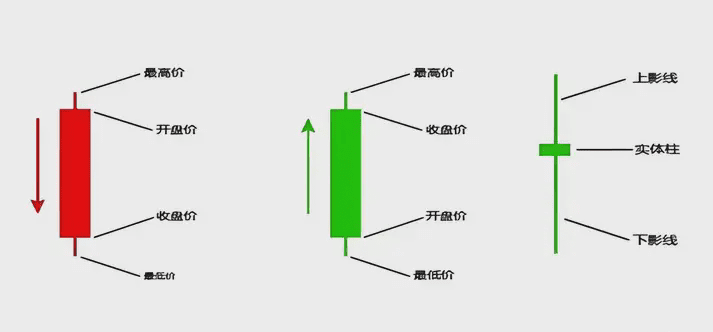
As shown in the figure. The opening price and closing price of the candlestick chart form a rectangle, and the two lines extending from the upper and lower parts of the rectangle are called shadows. If you select 15 minutes, it represents the transactions within 15 minutes. If you select one day, it represents the transactions within one day. As shown in the figure below, the upper and lower shadows represent the highest price and the lowest price respectively. The candlestick without shadows is called a bare-headed and bare-footed candlestick.
The K-line chart objectively tells us the process of market price changes, and plays an important role in helping us analyze and grasp the direction of the market. It can help us see the trend clearly and invest correctly.
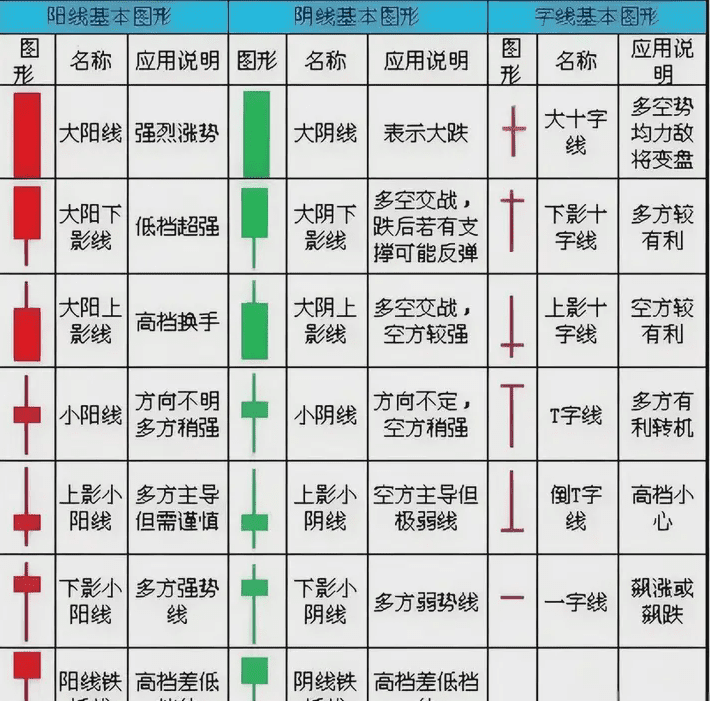
Look at Yin and Yang
Yin and Yang represent the trend direction. Yang lines indicate that the price will continue to rise, while Yin lines indicate that the price will continue to fall. Taking Yang lines as an example, after a period of long-short game, the closing price is higher than the opening price, indicating that the long side has the upper hand. According to Newton's mechanics, the price will continue to move in the original direction and speed without external forces. Therefore, Yang lines indicate that the price will continue to rise in the next stage, at least it can ensure that the price will continue to rise in the early stage of the next stage. Therefore, Yang lines often indicate that the price will continue to rise, which is also in line with one of the three major assumptions in technical analysis, that the stock price fluctuates along the trend, and this trend is also the core idea of technical analysis. Similarly, Yin lines continue to fall.
Look at the physical size
The size of the body represents the internal power. The larger the body, the more obvious the upward or downward trend, and vice versa. Taking the Yang line as an example, its body is the part where the closing price is higher than the opening price. The larger the Yang line body, the greater the upward power. Just like the physical principle that the greater the mass and the faster the speed of an object, the greater its inertial impulse, the larger the Yang line body, the greater its internal upward power, and its upward power will be greater than that of a Yang line with a small body. Similarly, the larger the Yin line body, the greater the downward power.
Look at the length of the shadow
Shadows represent turning signals. The longer the shadows in one direction, the less favorable it is for the price of the currency to change in that direction. That is, the longer the upper shadow, the less favorable it is for the price of the currency to rise, and the longer the lower shadow, the less favorable it is for the price of the currency to fall. Taking the upper shadow as an example, after a period of long-short struggle, the bulls finally lost their integrity and were defeated. Once bitten by a snake, you will be afraid of the rope for ten years. Regardless of whether the K line is Yin or Yang, the upper shadow part has constituted the upper resistance of the next stage, and the probability of the stock price adjusting downward is high. Similarly, the lower shadow indicates that the probability of the currency price attacking upward is high.
Bullish candle:
The red (white) entity refers to the rise of the day, the opening price is the lower end point of the entity, and the closing price is the upper end point of the entity. (The big positive line indicates a strong upward trend in the currency market, and buyers are rushing in crazily, buying without price limits. Coin holders are unwilling to sell because they see the strong buying momentum, and supply exceeds demand.)
Negative line:
The green (black) entity refers to the decline of the day. The opening price is the upper end of the entity, and the closing price is the lower end of the entity. (In the case of a big negative line, the seller has the upper hand from the beginning. The market is pessimistic, and the holders of the currency sell frantically, causing panic. The market is one-sided, and the price continues to fall until the closing.)
Generally speaking, the first 30 minutes of the opening is the most active time of the day. The opening price reflects the value judgment of ordinary retail investors. Retail investors usually choose to open or close positions just after the opening, so the opening price is usually near the highest or lowest point of the daily line, and then the price gradually tends to be rational. Generally, institutions choose to operate near the closing time to avoid closing positions overnight. (Note: The currency market is traded 24 hours a day, 7 days a week, which is different from the stock market)
The market is made up of these pillars, and it is these pillars that form various graphics, trends, etc. Let's discuss pressure and support together.
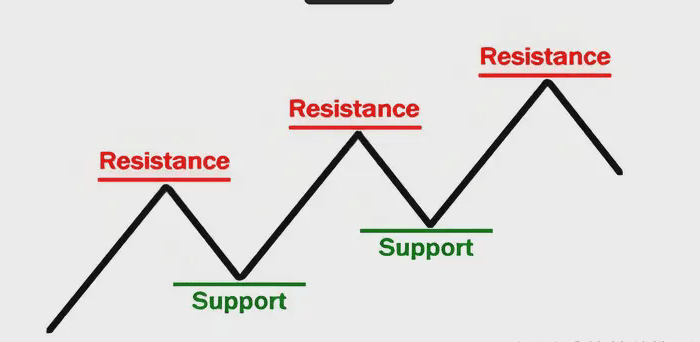
What is support?
Support level, as the name implies, is considered support at the bottom. In the K-line chart, when the price falls to a certain price, there is a rebound or trend reversal, then this price is called support level. Support level can be predicted by technical analysis.
The support level is a price where a buyer finds profit and eventually prevents the price from falling below the previous low point it created. The support line is when the price falls to a certain point, the price stops falling and may even rise again. This is caused by the long side buying at this price. This point that prevents the price from falling further is the support level where the support line is located.
There are generally several types of support levels:
1. Moving average support level
2. Support levels of highs and lows
3. Support level of the gap
What is the pressure point?
The pressure level is the opposite of the support level. The pressure level is at the relative top. When the price rises to a certain key price, there is a rebound or a trend reversal, then this price is called the pressure level. The pressure level can also be predicted by technical analysis.
It is worth mentioning that two consecutive support levels and two resistance levels will form a complete channel. This is more conducive to our analysis and prediction of the price direction. Of course, it is not just based on these that we can judge the buying and selling points, but also based on technical indicators such as moving averages and volume indicators to comprehensively analyze the market.
There are generally several situations for pressure points and support points:
1. Moving average pressure and support levels;
2. Pressure and support levels of high and low points;
3. The pressure level and support level of the gap.
Trading principles
Generally speaking, traders choose to go long at the support level and set the protective stop loss below the support level. Traders choose to go short at the resistance level and set the protective stop loss above the resistance level. The reason for setting the stop loss is that the market changes unpredictably, and even experienced traders who have been in the industry for more than ten years will be "played" by the market. Therefore, we must set the stop loss to prevent emergencies. In this market, making more money and less loss is winning, and the capital left will have a day to make a comeback.
Precautions
The strength of support and resistance depends on three factors: the length of the area (how long the area lasts), the height of the area (the increase), and the volume of the area. The more times the area is touched, the greater the increase or decrease, and the higher the volume, the stronger the support and resistance of this area.
When there is a conflict between K-lines at different time periods, we believe that the pressure and resistance levels on the long-term trend chart are more important than those on the short-term trend chart. In other words, the support and resistance formed by the weekly trend are more important than those formed by the daily trend.
So how do you determine the trend from the price candlestick chart?
Trends play an important role in trading, as traders use patterns in price data to make decisions, rather than relying solely on simple price fluctuations and intuition. So how do you find and draw trends in price charts?
When looking at a price chart like the one below, it’s not hard to notice that the price seems to be following some invisible lines. This is true no matter what timeframe you look at, whether it’s a weekly price chart, a daily price chart, or even a 30 minute price chart.
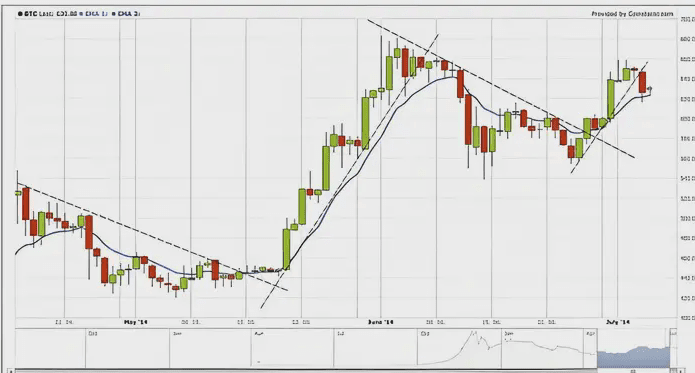
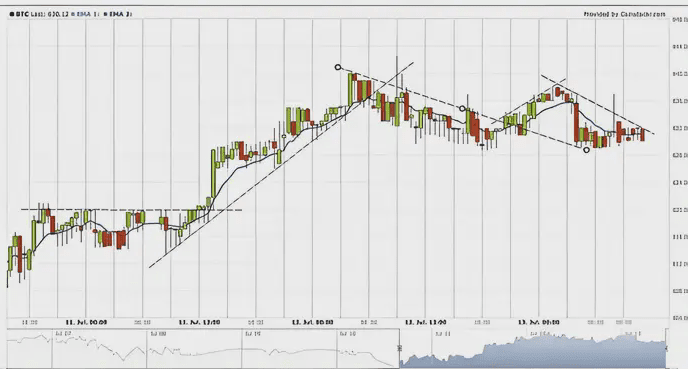
Trend lines and trend channels
The line in the picture is the so-called trend line. However, the price does not just follow the trend line, but usually moves back and forth between the upper and lower trend lines:
This is called a trend channel and is one of the most commonly used concepts in technical analysis. One of the characteristics of a trend is that it can be divided into small trend segments, which can be further subdivided:
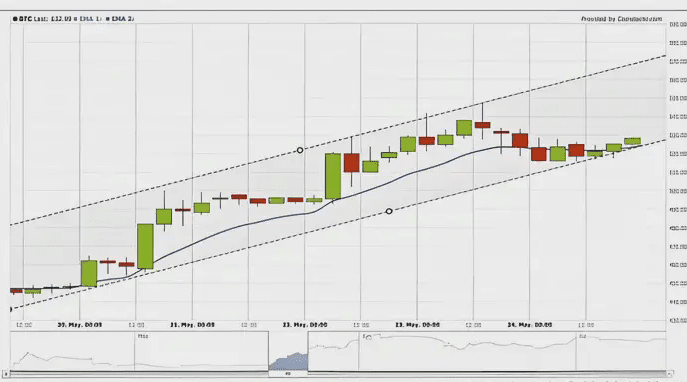
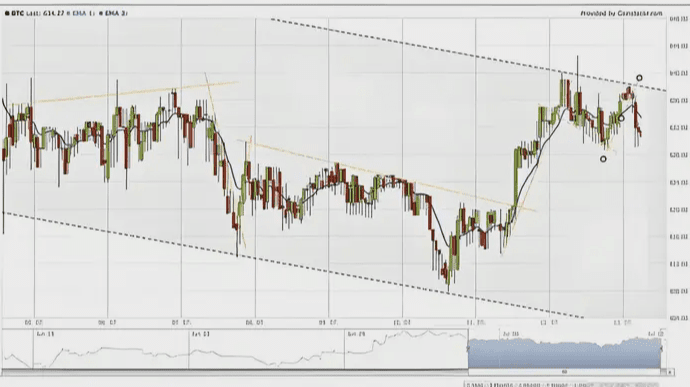
And an essential characteristic of price trends is that they can look extremely similar on different timeframes.
How to draw a trend line
Tiger PC provides drawing tools. You can also use tradingview to draw trend lines. When drawing, I tend to connect the "entity" edge of the K-line, because the negative line reflects the degree of panic more, which is not very helpful for us to understand the psychology of traders.
An upward trend connects the low points of the K-line, and a downward trend connects the high points of the K-line.
Trading principles
Go long in an uptrend, traders choose to go long when the price hits the trendline and place a protective stop loss below the trendline.
Shorting in a downtrend. The trader chooses to short when the price hits the trendline and places a protective stop loss above the trendline.
Precautions
The importance of a trend depends on three aspects: the time period, the length of the trend line, and the number of times the price is touched. The weekly level trend is more important than the daily level. The longer the trend lasts, the more important it is, and the more times the price touches the trend, the more important it is.
In practice, we will find that the steeper the angle between the trend line and the horizontal line, the shorter the trend will last, and the flatter the trend, the longer it will last. $(BABA)$ $(YRD)$
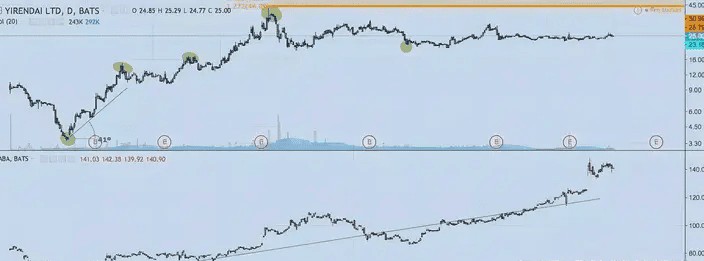
In addition, trading volume is also an important indicator for confirming the trend. In an upward trend, trading volume increases when prices rise and decreases when prices fall. In a downward trend, trading volume increases when prices fall and decreases when prices rise. If trading volume is inconsistent with stock price movement, it is a signal of trend reversal.
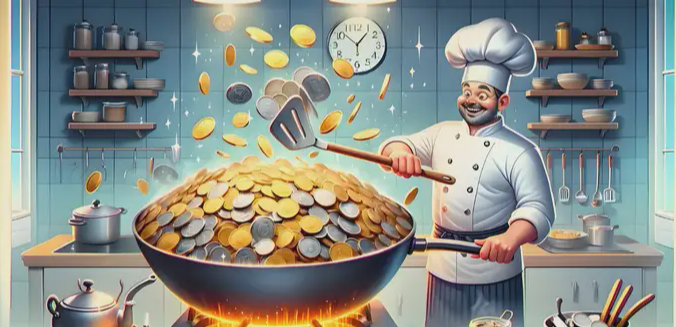
From big losses to big profits, I have summarized 10 iron laws to give all retail investors a piece of advice! If you want to play in the cryptocurrency circle for a long time, please read this article carefully! Newbies must keep them in mind to be able to navigate the market with ease.
The cryptocurrency world is a world full of opportunities and risks. Especially for novices, how to survive and make profits in a volatile market is a science that requires continuous learning and practice.
1. The hottest coins in the bull market fall the fastest. The hottest coins, especially those with serious market control, often burst the fastest. The more coins that attract a large number of retail investors to chase the rise, the greater the risk. Just like blowing a balloon, the bigger it is, the faster it bursts. The hottest coins in the bull market are often the favorites of short-term speculators, but they are also the traps that are most likely to make people lose all their money. Suggestion: Don't blindly chase the rise, especially those coins that have risen sharply in a short period of time. Stay calm and avoid becoming a "taker".
2. The routines of altcoins are similar. The way to play altcoins is usually to smash the market first to create panic, then slowly increase the price to attract retail investors to enter the market, and finally change the way to continue harvesting. This routine has been tried and tested, and novices are easily cut off. Suggestion: For altcoins, you must be mentally prepared, don't be confused by short-term gains, and don't easily hold a large position.
3. The long-term market trend is upward. Although the cryptocurrency market has experienced sharp fluctuations in the short term, the overall trend is upward if we look at the long-term trend. The historical trends of mainstream currencies such as Bitcoin and Ethereum have proven this. Suggestion: If you are a long-term investor, don’t be scared by short-term ups and downs. Hold high-quality assets patiently, and time will pay you back.
4. No one hypes up the potential coins. The real potential coins are often unknown at the bottom and few people mention them. The coins that are hyped up are often used by the dealers to harvest. The low-key coins may quietly explode at some point. Suggestion: pay more attention to those projects with solid technology and reliable teams that have not yet been hyped by the market. They may be the dark horses of the future.
5. Be careful with newly launched coins on exchanges, especially those that have skyrocketed and plummeted, which are often traps designed by dealers. Such coins usually have no actual value support and are purely for profiteering. Suggestion: For new coins, especially those that have huge fluctuations in the early stage of listing, stay vigilant and do not enter the market easily.
6. Rise and fall are common. If you buy, the price will fall, and if you sell, the price will rise. This is normal in the cryptocurrency circle. The market volatility is extremely high, and short-term rises and falls cannot fully reflect the value of a project. Suggestion: Keep a good attitude and don't panic because of short-term fluctuations. Formulate your own investment strategy and strictly implement it.
7. The most violent rebound does not mean the most potential. The coins with the most violent rebound are often not truly potential, but speculative. The rise of such coins usually lacks fundamental support, and they rise quickly and fall quickly. Suggestion: Don't be confused by short-term surges. The coins with real potential usually fluctuate more steadily and have an upward long-term trend.
8. Be careful of being cut off in case of sudden pullback If the coin you bought suddenly pulls back after a wave of increase, this may be a signal that the dealer has started to sell. The dealer usually attracts retail investors by raising the price, and then sells at a high price. Suggestion: When encountering a sudden pullback, stop profit or stop loss in time to avoid becoming the dealer's "taker".
9. Coins that explode in the second half In a bull market, coins that performed mediocrely in the early stage may explode several times or even more in the second half. These coins are like marathon runners, accumulating strength in the early stage and exerting strength in the later stage. Suggestion: Do not ignore those coins that performed mediocrely in the early stage but have solid fundamentals, as they may be dark horses in the later stage of the bull market.
10. Coins that have been sideways for several months may explode in the bull market. Some coins may be sideways for several months after experiencing several times of increase. This sideways movement is usually the result of the dealer accumulating strength and waiting for the next opportunity to explode. Suggestion: Keep an eye on the coins that have been sideways for a long time, as they may be the protagonists of the next round of market.
The market starts, and the income doubles! Follow Brother Cheng and follow the trend, and wealth will come naturally
Continue to focus: SPK, FIDA